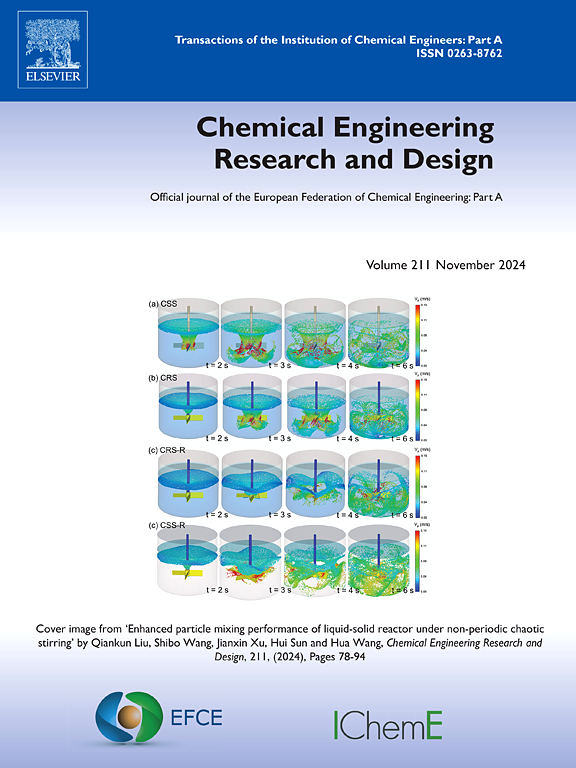在强制通风湿式冷却塔中使用氧化铝纳米颗粒的实验研究
IF 3.7
3区 工程技术
Q2 ENGINEERING, CHEMICAL
引用次数: 0
摘要
冷却塔在工业中用于去除工业流程和机器产生的多余热量。通过与纳米颗粒混合,可以改善这种冷却现象及其冷却速度。本研究的重点是设计和建造一种逆流强制通风冷却塔,在水中添加纳米氧化铝(Al2O3)颗粒,以增强热量& ;传质。实验中,水的流速、水温和纳米颗粒的体积分数(按体积分数从 0 % 到 2 %)都发生了变化。对性能系数(COP)、冷却特性系数(CCC)、蒸发率(ER)、冷却塔效率及范围等输出参数进行了分析。研究了不同体积分数的纳米流体特性,如粘度、密度和热导率。据观察,粘度和热导率随着体积分数的增加而增加。粘度随温度升高而降低,而热导率则随温度升高而升高。冷却塔实验结果表明,最大 COP、CCC、ER、效率和范围分别为 7.12、3.54、3.95 g/s、75.55 % 和 29.8ᵒC。在所研究的各种体积分数中,2% 的纳米流体具有更高的传热率和范围值,其性能优于其他纳米流体。与不含纳米颗粒的普通水相比,纳米颗粒体积分数为 2% 的纳米流体所需的补给水减少了 76.19%。此外,研究还发现,当空气流速和水流量分别为 13 米/秒和 3.5 升/分钟(LPM)时,当纳米流体的体积浓度从 0% 变化到 2% 时,冷却塔的范围、传热率和效率分别增加了 10%、10.2% 和 4.16%。本文章由计算机程序翻译,如有差异,请以英文原文为准。
Experimental investigation in a forced draft wet cooling tower using aluminum oxide nano particles
Cooling towers are used in industries to remove the excess heat produced by industrial processes and machineries. This cooling phenomenon and its rate can be improved by mixing it with the nanoparticles. The present work focuses on the design and construction of a counter flow forced draft cooling tower with the addition of aluminum oxide (Al2O3) nanoparticles with water to enhance heat & mass transfer. Experiments are performed with the variation of the flow rate of water, water temperature, and the volume fraction of nanoparticles from 0 % to 2 % by volume fraction. The output parameters like coefficient of performance (COP), cooling characteristics coefficient (CCC), Rate of evaporation (ER), cooling tower efficiency & range have been analyzed. Nanofluid properties like viscosity, density & thermal conductivity for different volume fractions have been examined. It is observed that viscosity and thermal conductivity increased with an increase in volume fractions. Viscosity decreased whereas conductivity increased with temperature rise. Results obtained from cooling tower experiments indicated a maximum COP, CCC, ER, efficiency, and range equal to 7.12, 3.54, 3.95 g/s, 75.55 %, and 29.8ᵒC, respectively. For the various volume fractions studied, nanofluid with 2 % outperformed others with higher heat transfer rates and range values. For the 2 % volume fraction of the nanoparticles, make-up water requirements reduced by 76.19 % when it is compared to the normal water without the nanoparticles. Also, it is found that the cooling tower range, heat transfer rate, and efficiency increased by 10 %, 10.2 %, and 4.16 % when nanofluid concentration is varied from 0 % to 2 % by volume for the air velocity and water flow rate of 13 m/s and 3.5 Liters per minute (LPM) respectively.
求助全文
通过发布文献求助,成功后即可免费获取论文全文。
去求助
来源期刊

Chemical Engineering Research & Design
工程技术-工程:化工
CiteScore
6.10
自引率
7.70%
发文量
623
审稿时长
42 days
期刊介绍:
ChERD aims to be the principal international journal for publication of high quality, original papers in chemical engineering.
Papers showing how research results can be used in chemical engineering design, and accounts of experimental or theoretical research work bringing new perspectives to established principles, highlighting unsolved problems or indicating directions for future research, are particularly welcome. Contributions that deal with new developments in plant or processes and that can be given quantitative expression are encouraged. The journal is especially interested in papers that extend the boundaries of traditional chemical engineering.
 求助内容:
求助内容: 应助结果提醒方式:
应助结果提醒方式:


